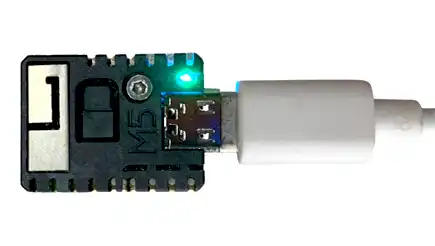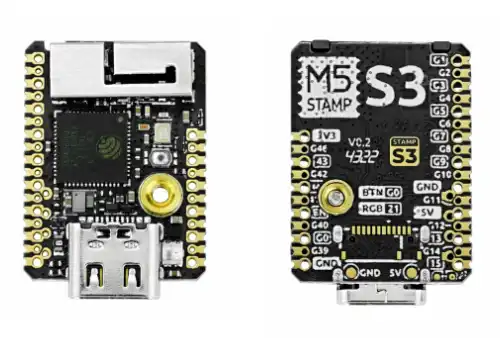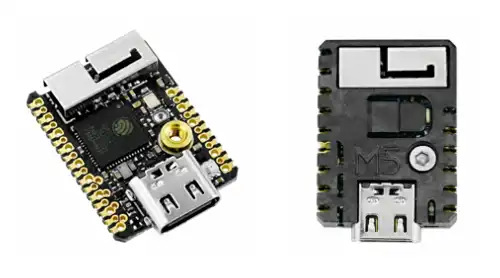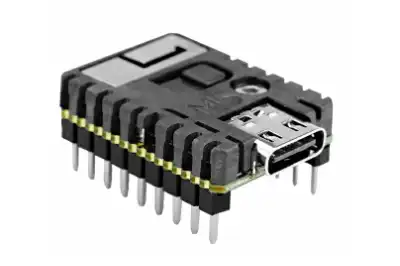The M5StampS3 is a development board from the manufacturer M5Stack, which stands out for both its technical characteristics and its compact size.
The M5StampS3 joins the rest of the members of the M5Stamp family. In it we find, among others, the original M5Stamp with ESP32 (without S3) and the M5StampC3.
All models in the M5Stamp range are distinguished by their features in a truly small footprint. However, with the M5StampS3 they simply have raised the bar to another level.

As the name suggests, the M5StampS3 is powered by Espressif ESP32-S3 SoC. In particular, we find an ESP32-S3FN8 SoC, which integrates a Xtensa® Dual-Core 32-bit LX7 processor with speeds of up to 240 MHz.
This SoC provides us with 384 KB ROM, 512 KB SRAM. In addition, the M5StampS3 comes with 8MB of flash memory, more than enough for the vast majority of projects.
This means that the M5StampS3 is capable of handling intensive processing tasks with ease. Whether you need to process sensor data or run complex algorithms, this embedded controller is up to the task.
As for wireless connectivity, the ESP32-S3 provides the M5StampS3 with - 2.4 GHz 802.11 b/g/n WiFi and Bluetooth 5 with speeds of up to 125 MB/s.
The M5StampS3 is designed to be “the brain” of our projects and other devices. So expansion capability is paramount. Here the M5StampS3 boasts and exposes the impressive amount of 23 GPIOs.
Considering its dimensions, this number is incredible. However, given its small size, to access all of them we will need to use a 1.75mm header. If we use the usual 2.54 pitch, not all pins will be available.
On the other hand, all pins are Castellated. That is, they go all the way to the end of the board. This allows it to be integrated into PCB Carrier boards, either permanently soldered, or by using some type of pressure socket.

Here is a summary of its main features:
CPU and memory
- SoC: Espressif Systems ESP32-S3FN8
- CPU: Xtensa® dual-core 32-bit LX7 microprocessor @240 MHz
- 384 KB ROM, 512 KB SRAM
- 8 MB flash memory
Connectivity
- 2.4 GHz WiFi, IEEE 802.11 b/g/n protocol, speeds of up to 150 Mbps.
- Bluetooth 5, Bluetooth Mesh, support for transmission speeds of 125 Kbps, 500 Kbps, 1 Mbps, 2 Mbps.
- 2.4 GHz 3D antenna.
Peripherals
- 23 GPIOs (G0, G1, G2, G3, G4, G5, G6, G7, G8, G9, G10, G11, G12, G13, G14, G15, G39, G40, G41, G42, G43, G44, G46)
- UART, I2C, I2S, SPI, pulse counter, PWM for LED and motors
- Headers with 2.54 mm and 1.27 mm pitch
- Castellated termination holes, for PCB mounting.
- Support for SD/SDIO/MMC.
- Touch sensor
- Optionally, 8-pin or 12-pin FPC connector with GPIO and LCD interface.
- User button.
- User RGB LED (WS2812B-2020).
- USB Type-C port for power and programming.
Power supply
- Input: 5V @ 500mA through the USB-C port.
- 5V to 3.3V DC/DC converter MUN3CAD01-SC
Dimensions
- Dimensions: 26 x 18 x 5 mm
- Weight: 3.2 grams
- Temperature range: 0 to 40°C
For power, the M5StampS3 incorporates an integrated MUN3CAD01-SC circuit that converts 5V to 3.3V reliably. This means that you can rely on your device to function smoothly and without interruptions due to voltage fluctuations.
It also has a UART converter, so that programming and Serial communication is as simple as connecting via USB-C. A great advantage over the original M5Stamp, which required an external programmer.
As if that weren’t enough, they have also managed to equip it with a programmable button and an RGB LED WS2812B. We can use them, for example, as user input and status indicator.
Finally, the set is completed with a flame-retardant housing and an Allen fixation screw. All this in a size of 26 x 18 x 5 mm and only 3.2 grams. It’s amazing.

Of course, it is fully compatible with the usual programming options, such as the Arduino IDE environment, PlatformIO, as well as the M5Stack UI Flow graphical environment..
The M5StampS3 is available for sale at a price of $7.50. A price somewhat higher than other development boards, but in my opinion justified by its impressive technical features and size.
In fact, the M5StampS3 series seems one of the best options available to include an ESP32 in our projects. Especially if they are to be integrated into a PCB that we make ourselves.
References:
